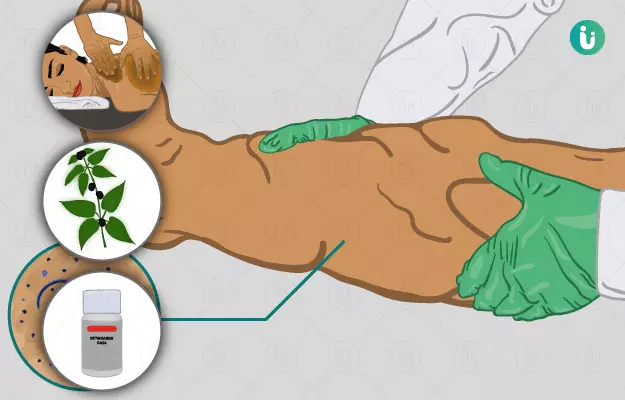Filariasis is an infectious disease caused by parasitic roundworms. Though it is not a life-threatening condition, it causes serious health problems, especially in the tropical and subtropical regions. Filariasis infection may lead to elephantiasis which is characterised by enlargement of the external genitalia, limb or any part of the body. This disease may be caused by one of the two nematodes, namely, Wuchereria bancrofti and Brugia malayi. The parasite may penetrate the skin either on their own or through the bite of a mosquito. The early stage of filariasis is characterised by headaches, chills, fever and skin lesions. Occasionally, individuals may be asymptomatic during the initial phase. If left untreated, the disease gradually progresses with swelling (elephantiasis) in legs, external genitalia or other body parts due to inflammation and obstruction to lymph flow.
Ayurveda describes various anti-parasitical and anti-worm herbs for treating filariasis, which includes kutaj (kurchi), vidanga (false black pepper), haritaki (chebulic myrobalan), guduchi (heart-leaved moonseed), manjishtha (Indian madder). Certain herbal preparations like nityananda rasa and saptanga guggulu and therapies like hot lepa (coating the affected body part with medication) and vamana (medical emesis) are effective in improving filariasis symptoms. Along with specific treatment for filariasis, Ayurveda advises dietary modifications and complete rest for filariasis patients, especially during fever.
- Ayurvedic view of filariasis
- Ayurvedic treatment for filariasis
- Ayurvedic herbs and medicines for filariasis
- Dietary and lifestyle changes for filariasis patient as per ayurveda
- How effective are ayurvedic medicines and treatments for filariasis
- Side effects and risks of ayurvedic medicine and treatments for filariasis
- Takeaway
Ayurvedic view of filariasis
Filariasis is termed as shlipada in Ayurveda and is described as a disease involving parasitic infestation in the tissues. It commonly occurs in places with standing water and stagnant water bodies. Dietary and lifestyle habits that increase kapha are considered to be the cause of swellings manifested in shlipada. Deranged mamsa and rakta dhatus along with kapha dosha are other factors that lead to swelling in calves and lower legs that are most commonly seen in filariasis. Swelling initially starts from the front portion of the leg and gradually spreads to the hips, legs, neck, nose and ears. Fever and severe pain are often associated with and precede the manifestation of swellings. Solid oedema results in stone-like hardening of legs and feet, which may also affect hands and scrotum. As the disease progresses, an imbalance in all three doshas is observed.
A predominant vitiation of vata dosha results in ulcers on the skin and mucous membranes, along with severe pain and fever with no apparent cause.
A predominant vitiation of pitta dosha characteristically manifests in swellings that are soft to the touch and have associated burning sensations.
Filariasis is caused due to a vitiation of kapha dosha which causes white, hard and smooth swellings.
Ayurvedic treatment for filariasis
- Vamana
- This is a bio-cleansing procedure used for elimination of kapha dosha observed in filariasis.
- It purifies the gastrointestinal tract and removes ama (toxins) and mucus from naadis (channels).
- Essentially, vamana is used for treating disorders caused due to excess kapha dosha or in conditions where kapha dosha is predominant such as filariasis.
- Herbs like kutaj are used for inducing vamana (vomiting) followed by herbs like pippali (long pepper), rock salt and warm water that further enhance the effect of vomit-inducing herbs.
- After this procedure, one is advised to rest and avoid talking or worrying. Also, it is recommended to keep their meals light or take liquid food.
- The outcome of a successful vamana therapy is calmness, ease, improved digestion along with improvement in disease symptoms and discomfort.
- Lepa
- Lepa refers to medical plasters that are prepared by mixing medicinal herbs with ghee or oil, to be applied to the affected area or the whole body, as per the condition. This procedure is especially useful in the treatment of inflammatory swellings and eliminating excess Kapha as seen in filariasis.
- Treatment of filariasis may also be done by applying a hot lepa, made from of kalka (paste or juice of leaves) of dhatura (devil’s snare), eranda (castor), and nirgundi (five-leaved chaste tree), bark of shigru (drumstick) and root of shweta punarnava (white hogweed) in rai taila (mustard oil), on the affected part.
Ayurvedic herbs and medicines for filariasis
Ayurvedic herbs for filariasis
- Guduchi
- This herb is widely used in Ayurvedic and folk medicine for its theraputic benefits.
- The alkaloid, lactones and glycosides (biological compounds) present in guduchi are useful in the treatment of a number of diseases including arthritis, stress, allergies etc.
- It's anti-inflammatory, jwarahara (anti-pyretic) and anti-infective properties aid in the treatment of filariasis.
- Kutaj
- This herb is extensively found all over India and is used in the form of seed or bark powder, kwatha (decoction), vati (tablet) or dietary supplement.
- Kutaj is most well known for its anti-diabetic, antidiarrheal and antioxidant properties.
- It is used as an emetic (induces vomiting) during vamana for filariasis.
- Vidanga
- Vidanga is one of the oldest herbs used in traditional medicine and has been extensively used in Ayurveda as a tonic.
- Vidanga is used in the form of asava and arishta (herbal wines), churna (powder), lauha (iron preparation) and taila (oil).
- In filariasis, vidanga is specifically used for it's emetic, anti-inflammatory and antihelminthic properties.
- Manjishtha
- This herb is mainly found in the north-west Himalayas, Nilgiri mountains and other hilly regions of India.
- Best known for its blood-purifying abilities, the root of this herb is used in Ayurvedic medicines in the form of a decoction, paste, powder or ghee.
- Manjishtha is effective in the treatment of swellings caused by kapha disorders such as in filariasis
- Haritaki
- Haritaki is helpful in treating diseases of the digestive, nervous, respiratory and female reproductive systems.
- It acts as a rejuvenator, tonic and laxative (regulates bowel movement) agent.
- The anti-helminthic property of haritaki is effective in clearing out filarial worms from the body.
- Powdered fruit rind of haritaki, fried in eranda oil, when taken with warm water or milk twice a day is found to be beneficial in the treatment of filariasis.
Ayurvedic medicines for filariasis
- Saptanga guggulu
- This preparation is mainly used in the form of a vati (tablet) and consists of guggulu (Indian bdellium tree) as its basic ingredient.
- It also contains triphala (a combination of amalaki [Indian gooseberry], vibhitaki [belleric myrobalan], and haritaki) and trikatu (a combination of the three acrids – pippali [long pepper], shunthi [dried ginger], and maricha [black pepper]).
- Saptanga guggulu is usually taken in the dosage of 500 mg twice daily and has anti-inflammatory effects, which is beneficial in reducing swelling in filariasis patients.
- Nityananda rasa
- Nityananda rasa is a compound formulation administered in the form of a vati (tablet).
- It consists of haritaki as one of its main ingredients.
- This medicine helps in reducing lymphoedema, pain and tenderness in the body, all of which are the major symptoms of filariasis.
- It also significantly brings down fever and chills associated with filariasis.
As treatments vary according to numerous factors and an individual’s prakriti (constitution), consult a qualified Ayurvedic doctor for appropriate medications and treatments for your specific complaints.
Dietary and lifestyle changes for filariasis patient as per ayurveda
Do’s
- Add rasonam (garlic) to your diet .
- Cereals like yava (barley), old shashtika type of rice, and pulses like kulattha (horse gram) and mudga (green gram) should be included in the diet.
- Vegetables like brinjal, karavellaka (bitter gourd), mulaka (radish), leaves of paravala (pointed gourd), and upodika (Indian spinach) are beneficial in the treatment of filariasis.
- Consumption of bitter- and pungent-tasting food items and eranda taila are encouraged for those with filariasis.
- Take adequate rest, especially if you are down with fever.
Don’ts
How effective are ayurvedic medicines and treatments for filariasis
Clinical studies report that regular use of nityananda rasa is effective in reducing lymphoedema, pain and tenderness associated with filariasis. It also reduces fever and rigours.
According to a study published in the American Journal of Ethnomedicine, a polyherbal poultice prepared from manjishtha as one of its primary ingredients is widely and effectively used as a topical folk remedy for the treatment of filariasis in Bangladesh. Though more studies are still needed to ascertain the mechanism of action and active ingredients, its efficacy couldn’t be ruled out.
Side effects and risks of ayurvedic medicine and treatments for filariasis
Although Ayurvedic treatment procedures and herbal medicines do not have any side effects, there are quite a few precautions that one has to pay heed to before undergoing these treatments. These include:
- Manjishtha should be avoided in case of severe chills or increased vata dosha as it is known to aggravate vata.
- Overdose and prolonged use of kutaj should be avoided as it is known to cause hyperglycaemia and hepatotoxicity.
- Vamana is contraindicated in pregnant women, those with excess vata disorders, emaciated elderly persons or children and in case of heart problem or hypertension. It should be avoided in those with weakness, enlarged spleen, distended abdomen, blindness or urinary retention. This procedure is performed in individuals with vitiation of kapha dosha alone or when kapha dosha is predominant, but never when pitta or vata dosha is dominant.
- One must always consult a physician, before taking any medicinal herb to know the right dosage which is specific to disease symptoms and individual prakriti.
Takeaway
Filariasis is an infectious disease caused due to nematodes Wuchereria bancrofti and Brugia malayi. It accounts for not only physical damage to the affected person but also a substantial financial loss due to the cost of treatment. If left untreated, filariasis advances into the dreaded condition of progressive oedema known as elephantiasis. Ayurvedic treatment of filariasis comprises the administration of anti-parasitic and anti-helminthic herbs and herbal formulations along with lepas and vamana therapies. Complete rest and dietary modifications like maximum use of rasonam is also recommended for effective treatment and overall improvement in health
Find Ayurvedic Doctor in cities
Doctors for Ayurvedic medicine, treatment and remedies for Filariasis

Dr. Ayush Bansal
Ayurveda
2 Years of Experience

Dr. Megha Sugandh
Ayurveda
6 Years of Experience

Dr. Nadeem
Ayurveda
3 Years of Experience

Dr.Ashok Pipaliya
Ayurveda
12 Years of Experience
References
- National Health Portal [Internet] India; Filariasis.
- National Organization for Rare Disorders [Internet]; Filariasis.
- Swami Sadashiva Tirtha. The Ayurveda Encyclopedia: Natural Secrets to Healing, Prevention, and Longevity. Sat Yuga Press, 2007 - Body, Mind & Spirit .
- National Institute of Indian Medical Heritage [Internet]. Central Council for Research in Ayurvedic Sciences: Ministry of AYUSH, Government of India; Sūryāvarta.
- Upadhyay AK, Kumar K, Kumar A, Mishra HS. Tinospora cordifolia (Willd.) Hook. f. and Thoms. (Guduchi) - validation of the Ayurvedic pharmacology through experimental and clinical studies. Int J Ayurveda Res. 2010 Apr-Jun;1(2):112-21. PMID: 20814526
- Jamadagni PS et al. Review of Holarrhena antidysenterica (L.) Wall. ex A. DC.: Pharmacognostic, Pharmacological, and Toxicological Perspective. Pharmacogn Rev. 2017 Jul-Dec;11(22):141-144. PMID: 28989249
- Rajkumar Harinkhede et al. Specific Therapeutic Panchkarma Procedure in Pediatric Patients: A Classical Review. International Journal of Research in Ayurveda and Pharmacy. 8( Suppl 2) 2017
- Samsun Nahar et al. Ayurvedic Influences and Novel Combination of Phytotherapy and Zootherapy by a Folk Medicinal Practitioner of Domar Upazila in Nilphamari District, Bangladesh. American Journal of Ethnomedicine. 2017 Vol.4 No.2:17.
- Kannan P, M. S. Krishnamurthy, Suchitra N Prabhu. Experimental Evaluation Of The Anti-Inflammatory Activity Of Saptanga Guggulu Prepared By Guggulu Shodhana With Four Different Media In Wistar Strain Albino Rats. International Ayurvedic Medical Journal.
- Yadav Babita et al. A Perspective Study of Haritaki. International Journal of Research in Ayurveda and Pharmacy. 2 (5) 1466-70
- Goli Penchala Prasad, ML Naidu. Effect of Kuberaksha Patra Churna, Vriddhadaru Mula Churna and Kandughna Taila in Shlipada (Manifested filariasis) . International Quarterly Journal of Research in Ayurveda. 2012, Volume : 33, Issue : 1, Page : 102-109












